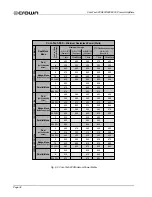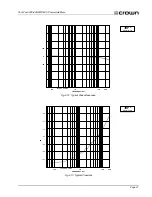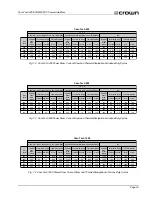
Page 44
Com-Tech 200/400/800/1600 Power Amplifiers
8 Accessories
8.1
P.I.P. Modules
One advantage of
Com-Tech amplifiers is the ability to
customize them using
P.I.P. (Programmable Input Pro-
cessor) modules.
Com-Tech amplifiers are equipped
with an edge card connector inside the back panel
P.I.P.
compartment. The modules install easily:
FTE
Programmable
Input Processor (P.I.P.)
C H - 2 I N P U T
C H - 1 I N P U T
+
–
+
–
P.I.P.-FTE
includes all P.I.P.-FXT features, and adds
12 dB/octave RFI filters, variable 18 dB/octave high-
pass filters, and 6 dB/octave 3 kHz shelving networks
for “constant-directivity” horn equalization. Screw ter-
minal plugs are provided for input.
P.I.P.
3
1
2
GND
Programmable
Input Processor
C H - 2
C H - 1
DATA OUT
AUX
DSPI
DATA IN
CROWN
BUS
PUSH
PUSH
AUDIO IN
AUDIO IN
IQ-P.I.P. v1.3
integrates the amplifier into Crown’s pat-
ented
IQ System.
®
The IQ System provides centralized
computer control of 1 to 2,000 amplifiers. Each ampli-
fier channel can be monitored and controlled from an
inexpensive personal computer. Any combination of
mic- and line-level signals can also be mixed and routed
with optional
MPX-6,
™
SMX-6
™
and
AMB-5
™
mixer/mul-
tiplexers, and the MRX series matrixers.
IQ-P.I.P. v1.4
Smart Amp
™
offers the monitoring and
control features of the IQ-P.I.P. v1.3
plus the capability
to function as a stand-alone unit as part of the
IQ
System’s distributed intelligence.
™
Features include a
smooth output limiter for transparent loudspeaker pro-
tection, power supply gates for energy savings,
ODEP
conservation which protects the output devices with
precision input signal control, interrupt-driven report-
ing that lets you define error conditions, and configur-
able short detection.
CLP
Programmable
Input Processor (P.I.P.)
3
1
2
GND
I N P U T
I N P U T
C H - 2
C H - 1
PUSH
PUSH
P.I.P.-CLP
is designed to detect and prevent overload.
Its compressor is driven by the amplifier’s built-in
IOC
error detection circuitry. Unlike typical signal-driven
compressors, it only compresses the signal to prevent
overload. It can deliver up to 13 dB of additional head-
room without being noticeable.
Note: In Fire Protective Signaling Systems, the Com-Tech 200 may
use the P.I.P.-BB, P.I.P.-ISO or P.I.P.-UL1711, however the Com-Tech
400, 800 and 1600 may only use the P.I.P.-UL1711.
WARNING: Disconnect power to the amplifier when in-
stalling or removing a
P.I.P. module.
Here are some of the available
P.I.P. modules:
AMC
Programmable
Input Processor (P.I.P.)
O U T P U T
I N P U T
3
1
2
GND
P.I.P.-AMCb
unites many features of the P.I.P.-XOV and
P.I.P.-CLP. It offers a variable 4th-order Linkwitz-Riley
crossover and an
IOC-driven, variable threshold com-
pressor. In addition, it provides “constant-directivity”
horn equalization and filter-assisted B
6
vented box
equalization. Biamping and triamping capabilities are
provided via XLR connectors.
Programmable
Input Processor (P.I.P.)
I N P U T
3
1
2
GND
PUSH
C H - 2
C H - 1
PUSH
I N P U T
EDC
b
P.I.P.-EDCb
combines a sophisticated error-driven com-
pressor and smooth limiter with a subsonic filter for each
channel. The compressors have adjustable attack and
release times, and can be set to track each other. The
compressors activate when a signal will clip the input,
an
IOC error occurs, or the output exceeds the selected
threshold. The subsonic filters have corner frequencies
of 24, 28, 32 and 36 Hz.
P.I.P.
MOD
ULE
BACK PANEL
OF AMPLIFIER
Fig. 8.1 Installing a P.I.P. Module






































